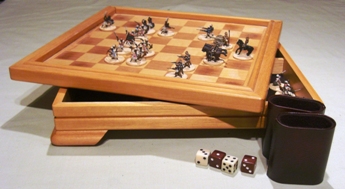 |
The prototype
PORTABLE WARGAME was made from an old wooden chessboard.
The board was also the lid of a wooden box that had been
used to store the chessmen when the game was not in use.
This space proved ideal for storing the figures, dice,
and dice cups required to play the first draft of the
rules.
Although no longer used, this prototype has pride of
place in Bob Cordery's wargames room. |
The prototype proved the viability of the PORTABLE
WARGAME concept, and the next stage in its development
used a larger vinyl chessboard.
This had the advantage of having larger grid squares -
which allowed more and/or larger figures to be placed in
each square - as well as having the capability of being
rolled up when not in use.
It was also possible to temporarily 'fix' terrain items
to the chessboard using Copydex rubber glue. |
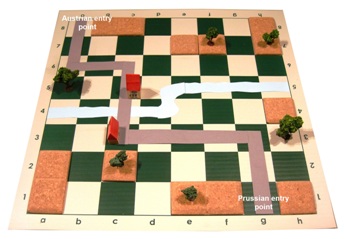 |
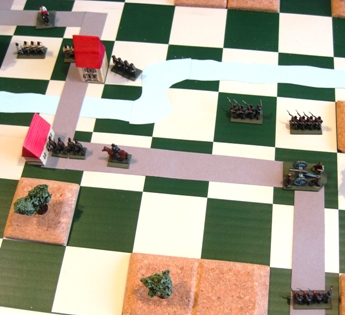 |
The terrain used was
made from thin cardboard (the river and the roads),
pieces of cork floor tile that was cut to size and
gently shaped (the hills), commercially available trees
(ready0made trees from Essex Miniatures), and houses
from a 'Village in a bag' set sold in various toy shops
and online.
The figures used were very old Peter Laing 15mm-scale
Austrians and Prussians from the range of nineteenth
century figures that were on sale in the 1980s. |
Having proved that the rules worked and produced a
satisfactory wargame, the next stage in the development
of the PORTABLE WARGAME saw a change of historical
period (from Horse & Musket to Modern) ... and the
introduction of an even larger grid.
The grid used was originally constructed for another
game, but the size of the grid squares (4" x 4"/10cm x
10cm) allowed the use of 20mm-scale figures and
vehicles.
The changes required to make the rules suitable for the
later historical period were based upon ideas put
forward by Joseph Morschauser ... and worked very well
indeed. |
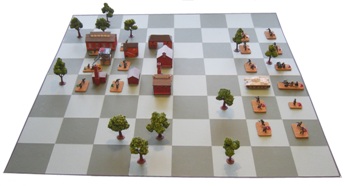 |
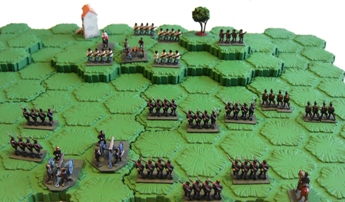 |
Although the
original rules had been written for a square grid, many
wargamers own hexagonal wargames terrain, and the next
development saw experiments using hexed terrain.
As Bob Cordery had a large quantity of reasonably
portable Heroscape™ terrain available, the first battles
using the hexed grid version of the rules utilised
painted Heroscape™ terrain and the old
Peter Laing 15mm-scale Austrians and Prussians.
These play-test battles proved that the rules would work
- with minor modifications - with both squared and hexed
grids. |
Having reached the stage where the Portable Wargame
seemed to be about as developed as it was likely to
become, Bob Cordery moved on to other things ... for a
while.
During this break in development a small group of
enthusiasts were enjoying using the rules and eventually
they prevailed upon Bob Cordery to resume the
development of the Portable Wargame concept.
The first new versions of the rules included some
much-needed changes that made it possible for Units to
become degraded by combat rather than being totally
destroyed as a result of a one-off fight with another
Unit.
Players had also requested changes to the rules that
allowed grid were large than 8 x 8 to be used, and from
this was born the Big Board Portable Wargame. |
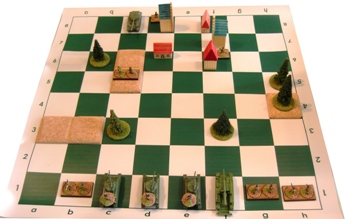 |
 |
The layout used for the Big Board
Portable Wargame rules proved very popular, and
in late 2012 Bob Cordery reformatted his existing MEMOIR
OF BATTLE AT SEA rules so that they were compatible with
them. He also renamed the rules and they became the
PORTABLE NAVAL WARGAME rules. |